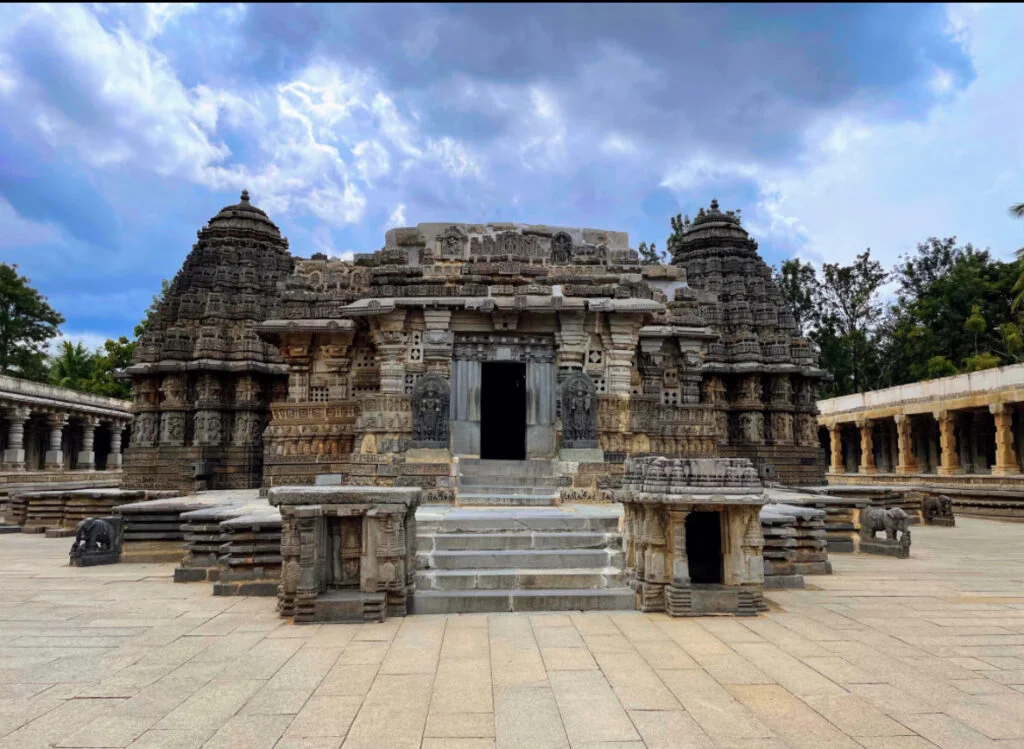Read this travelogue on the Hoysala temples, written by traveler Jayanthi Chandrasekaran. These temples have been identified recently as World Heritage sites by UNESCO.

The famed Hoysala temples of Belur, Halebid, and Somnathpura in Karnataka, termed as the sacred ensembles of Hoysalas, have been added to the UNESCO World Heritage list of 2023. It is a matter of pride and prestige to be recognized internationally. Besides boosting tourism revenue, these monuments also become eligible for financial assistance from the World Heritage Fund. The World Heritage sites also get legal protection under the World Heritage Convention.
The Hoysalas ruled most of the modern state of Karnataka between the 10th and 14th centuries. The beginning of the 11th century saw many temples being built by the rulers. With time the emphasis shifted from architecture to sculpture due to the discovery of soapstone, which when quarried fresh, is relatively soft and easily carved. Once exposed to elements it starts to harden over the years due to moisture escaping from the stone, hence the durability of the structures. The easy availability of soapstone locally became a boon for the Hoysala sculptors who carved the temples with the artistic meticulousness of a goldsmith and the errorless precision of a surgeon combined.
The Hoysala temple unit in general consists of a vimana connected by its short antarala (antechamber) to a closed navaranga (3 x 3 grid) which may often be preceded by another mandapa. The marked preference for the star-shaped external configuration of the temples seems to provide a larger surface area for the execution of the prolific sculptures and carvings, which became Hoysala’s signature. The temple unit is generally surrounded by an open courtyard and pillared cloister and a single entrance doorway. The finest of the early Hoysala temples are the Chennakeshava temple at Belur (1117CE), the Hoysaleshwara temple at Halebid, (1121CE), and the Keshava temple at Somnathpura (1258CE) reflecting the creative brilliance of the 12th and 13th-century architects.
Belur, Chennakeshava Temple

The Chennakeshava (handsome Keshava) or Vijaya Narayana temple at Belur was commissioned by King Vishnuvardana to commemorate his victory over the Cholas in Talakkad. The King’s aspiration to surpass the Chalukyan architecture in terms of scale and embellishments to prove the Hoysala supremacy made this temple grandiose in ornamentation. In the epigraphs, Belur is referred to as earthly Vaikunta and Dakshina Varanasi.

The inscription on the east wall of Channakeshava temple declares that King Vishnuvardana constructed the temple and installed Vijaya Narayana in 1117CE after his conversion to Vaishnavism from the Jain faith by the celebrated Ramanujacharya. It is the largest and most elaborate of the Hoysala temples and is covered in intricate carvings depicting gods, goddesses, and scenes from Hindu mythology.
The finest among the carvings are the madanikas (chaste maidens) for which Vishnuvardhana’s queen Shantala Devi was considered a model. In one of the madanika sculptures carrying her pet parrot, the bangle on her right hand could be moved up and down.
Halebid, Hoysaleshwara Temple

The Hoysaleshwara temple at Halebid, the former capital of the Hoysala empire, is a twin temple dedicated to the Hindu God Shiva. The two virtually identical but separate temples for Hoysaleshwara and Santaleshwara Shiva lingas, named after the masculine and feminine facets, stand on a large single platform, connected at the inner arms of their transept. For the sheer wealth of sculptural embellishment and intricacy of chisel work, there are few temples in India to compare with this monument. An inscription found about five kilometers from the temple site, near the Kalleswara temple ruins in Ghattadahalli indicates that the construction began around 1121CE by the orders of one Ketamalla, an officer with King Vishnuvardana. It was completed some years later by Kedaroja, the architect of Vishnuvardana’s son and successor, King Narasimha I. It also notes that the King made a grant of lands to support the construction, operation, and maintenance of the Shiva temple.
Somnathpura, Keshava Temple

This 13th-century Keshava temple at Somnathpura (40 km from Mysuru) is a fine example of the fully evolved Hoysala architecture. The relatively small yet exquisitely carved temple is known for its harmonious proportions and pillared cloisters on three sides. Somnathpura Keshava temple is a Trikuta (three-shrine) temple dedicated to Lord Krishna in three forms – Janardhana, Keshava, and Venugopala. As the main Keshava idol was lost and the other two idols have been damaged, it’s no longer an active temple, unlike the temples at Belur and Halebid. Nevertheless, due to renovations undertaken in the 15th century during the Vijayanagara period and the 20th century by the erstwhile princely state of Mysore, the temple exudes timeless beauty.
The ensembles of these three sacred temples stand as a testament to the enormous amount of labor, engineering, and artistic skills of the sculptors and the intelligence, courage, and patience of the Hoysalas as rulers.
ALSO READ: Irresistible Rosslyn Chapel [Travelogue by Jayanthi Chandrasekaran]
Enjoyed this travelogue written by traveller Jayanthi Chandrasekaran? Now you can also write your own travelogue here and share your travel experience with the world.
